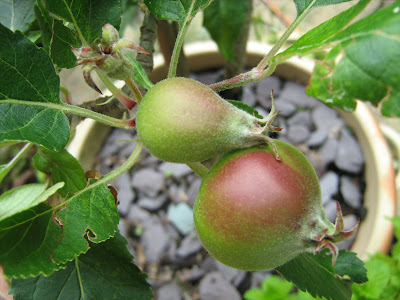June Drop

Spring saw the most fruit blossom I've seen on our trees: probably a combination of the hard winter then some relatively mild weather at flowering time which conspired to maximise the gorgeous froth we saw earlier this year. The weather was also mild enough before the frosts started up again to ensure the largest fruit set I've ever witnessed: each fruiting spur having at least 6 fruits (as many as 12 in lots of cases) beginning to swell and mature.
I was anticipating I'd have to do lots of fruit thinning this year. However, as usual nature is doing her job well and is sorting things out for me. There's now the most spectacular June Drop I've ever seen with my apple, pear and plum trees. It's the time of the year when damaged or smaller fruits simply drop off the tree, allowing their larger, more hale and hearty cousins to ripen into the harvestable fruit. I reckon the very dry weather we've had over the past couple of months is the reason for most of the fruit falling. After all, the tree wants to get some fruit to a viable reproductive stage, rather than as many immature fruit as possible. Water is the key element from now on for that goal to be achieved.
Of course, I'll still have to do some thinning soon (and picking up the windfalls in August/September), but the job's looking like it'll be about the same as usual now. Guess which apple I'll be leaving from those pictured, if the others don't drop of their own accord over the next couple of weeks. The one on the left looks like it'll probably fall quite soon, but I'm not so sure the one in the middle wants to go. Ideally I'd like to keep the one on the right, but if this one drops, I'm sure the middle one will still produce a tasty apple.
It's tempting to leave all of them on there I know, but beware: too many fruit can stress the tree. You'll get smaller, not so tasty fruit as a result and also risk the tree not producing such a good crop the next year whilst it recovers. Worse still, it might switch into biennial bearing and give you a crop every other year instead of an annual one. If that happens, then follow this advice from the RHS to bring your trees back on track.










I am going to have to go out and check my apple trees - although it is too early for us to be worrying about thinning yet. Good advice here.
ReplyDeleteThanks Commonweeder and you've made a good point re the timing of thinning. Here in the UK it's usually a task for July, so that mother nature gets the best chance to do the job first!
ReplyDeleteOne of our allotment apple trees is a bit of a biennial bearer. It's having its good year and is absolutely smothered in fruits so I must force myself to thin massively and try to get it back on track. Will wait til June drip does its thang tho, first.
ReplyDeleteToo late -After a bumper crop last year, I've got two mean little coxs apples on my tree... oh well
ReplyDeleteJune drop often alarms people, especially if it's a heavy one. But thinning is so important, and your comments about the problem with biennial cropping are right on the button.
ReplyDeleteIt happens with ornamentals,too. Our relatively young lilac (variety 'Firmament') was smothered with blossom this year. I'm expecting virtual crop failure next, since it is already badly behind in putting on new growth. Not a lot I can do about that.
Thanks for brilliantly informative post.
Lia - as you know some trees have a tendency to be biennial bearers anyway.
ReplyDeleteLinda - welcome! At least you know what to do now
Nige - so lovely to see you back and to have you adding so much more to my posts as usual :)